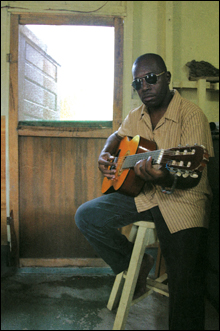
The story of Central America’s Garifuna people begins in 1635 with a shipwreck. The survivors — West African slaves — swam to safety and freedom on the island of St. Vincent, where they interbred with Carib and Arawak Indians. Their descendants now live in Belize, Honduras, and a diaspora of communities around the world. Mostly poor and disenfranchised, the Garifuna fear the disappearance of their hybrid culture. But veteran singer Andy Palacio of Belize has dedicated his career to preventing that from happening. With a new, multi-generational band, the Garifuna Collective, and an enchanting debut release, Watina (Cumbancha), Palacio, who plays at the Museum of Fine Arts this Wednesday, is making headway at last.
Born in a small village of 200 people in Baranko, Palacio says he was exposed to rural Garifuna culture among people who lived off “subsistence farming and fishing. We spoke Garifuna,” he continues, “but on the school grounds we were required to speak English.”
Partying and prayer are African music staples. Garifuna music is a reflection of that. As Palacio details, “Within the Garifuna community, there are musics for festive occasions, like punta and paranda, and also for healing ceremonies, like hüngü hüngü.” But Garifuna songs are unique: their mournful melodies and reedy vocal harmonies echo mysterious, and now-extinct, Caribbean Indian cultures.
For Palacio, the road from a rural Garifuna childhood to the recording studio was not an easy one. “In my pre-teen years, I picked up my father’s harmonica. He also had a guitar, and he loved to sing. But he grew up in the colonial period with the church choral tradition. He didn’t sing in Garifuna. Garifuna music was not seen as worth recording.”
Garifuna culture was paid little respect until the rise of the party-pop genre called “punta rock” in the late-’70s. The craze hit Belize City just as Palacio was launching his career, and he embraced it. As he rose to become one of the region’s most popular singers, he mixed punta, reggae, and pop into an increasingly electric and hard-hitting sound. A few years back, Ivan Duran of Belize’s Stonetree Records encouraged Palacio to try out a more acoustic, rootsy approach with both young and older Garifuna. The musicians lived together in a fishing village for weeks, composing and arranging. The vocal harmonies they developed recall early Bob Marley and the Wailers, as do the laid-back rhythms. But from the punchy beat and sensuous, growling vocal of the title track to the searing balladry of “Ayu Da” — Garifuna elder Paul Nabor’s tribute to a boyhood friend who perished on a fishing trip — these songs create a sound and a mood of their own.
Palacio says he went from “from high tech to low” with Watina. “The songs are as diverse as our experiences. There’s one theme that seems to permeate the album — the spiritual connection, the belief in the higher power that gives us guidance, protection, and wisdom.”
“Weyu Larigi Weyu (Day by Day)” draws on sacred rhythms in a prayer for survival, as does the moody closer, “Amuñegü (In Times To Come).” But the most satisfying songs are more upbeat, like the hook-laden “Miami,” a lively paranda with lyrics decrying the real-estate development that drives Garifuna from their ancestral lands. “Beiba (Go Away)” uses percussion-laden, one-chord Garifuna funk to scold a drunken husband. The album isrich with voices, drums, and acoustic and electric guitars, but never so fussy as to squelch the session’s spontaneity. And the presence of Nabor, a weathered septuagenarian with a reedy voice, offers a living metaphor for the idea of cultural survival.
Andy Palacio and the Garifuna Collective | Museum of Fine Arts, 465 Huntington Ave, Boston | August 1, 7:30 pm | 617.369.3306